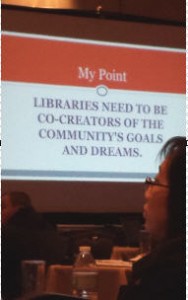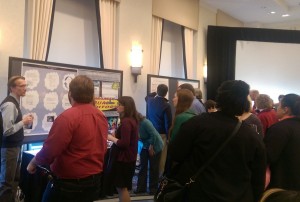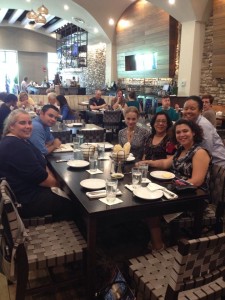In the spirit of one of the sessions I attended, I will make this personal. Not all of the conference take-a-ways can be defined by the conference program, or even found in the videos that appear on the conference webpage after the fact. To be sure, the content of the sessions were interesting and often brought about things that I hadn’t anticipated being important, but the conversations between sessions, and at dinner were just as important as the content of the sessions.
Most useful sessions for me:
Customer Development M.J. D’Elia, Head, Learning & Curriculum Support, McLaughlin Library, University of Guelph. M.J. presented a model based on techniques of startup companies. In this model, assumptions of the service provider are tested as users give valuable information, either directly, or indirectly, that identifies their real needs. This model helps to set expectations at the beginning, and to get valuable insight from early adopters. It allows service providers to keep an eye open for indicators of success from the customer’s perspective, making pivots in different directions easier when off track, and allows managers to better support growth based on the results of evaluations. Asking the right questions is key. One question might be; “Were there enough computers?” A follow up question might be; “How important was that to your satisfaction of the service?” The slideshow from that session can be found here. (This has already been something I have used for the video editing training service that we will be offering in WB and GH.)
http://www.slideshare.net/mjdelia/intro-to-customer-development-for-libraries
http://conferences.infotoday.com/documents/219/D201_DElia.pdf
Impact Measures Moe Hosseini-Ara, Director, Markham Public Library. Moe talked a great deal about connecting to the operational, and strategic goals of the larger organization. He also talked about making the statistics relevant to these goals, and in using statistics to tell a story that is both representative of the work, and meaningful. The goal is to collect and communicate the right statistics, which also means not collecting statistics that are no longer working toward the changing goals of the organization. (This will be useful for the video editing training service that we will be offering in WB and GH.)
http://s.uconn.edu/moelogicmodel
Video Streaming Tips & Learnings Marcus Ladd, Special Collections Digital Librarian, Miami University Elias Tzoc, Digital Initiatives Librarian, Miami University. The presenters talked about Kaltura http://corp.kaltura.com/ Pointed to an article, admittedly dated, called “Video use and Higher Education” http://s.uconn.edu/videouseandhighered (This talk was useful to the video editing training service that we will be offering in WB and GH.)
Community Librarian… Shelley Archibald Community Librarian, Technology Burlington Public Library. Shelley talked about engaging diverse groups in community building. She wrote, “Libraries need to be co-creators of the community’s goals and dreams.” (This gave me some ideas to enhance a class I plan on teaching with the OLLI program in Waterbury Spring 2016.)
Storytelling: Diane Cordell, Consultant and Writer, CyberSmart Education Company. (This gave me some ideas to enhance a class I plan on teaching for the OLLI program in Waterbury Spring 2016.)
Other Good Stuff:
Search tips: by Mary Ellen Bates, Bates Information Services, Inc.
http://conferences.infotoday.com/documents/219/A101_Bates.pdf
Building Community Partnerships: Melissa Christakos, Coordinator of Reference Services, Chesapeake Public Library. Melissa got me thinking about how to use a Memorandum of Understanding. (This has already been something I have used for the video editing training service that we will be offering in WB and GH.)
I attended other presentations on metrics, and a few on webapps that were quite informative, and provided many links. Look for those in the links to the presentations below. I’ll look through some of my other notes, and will post a reply here if there is anything else that really stood out as noteworthy.
Links to many CIL presentations:
http://computersinlibraries.infotoday.com/2015/Presentations.aspx
http://www.librarysummit.com/DC2015/Presentations.aspx





